| Please access the following URL if you want to secure using SSL. All pages in the site will be secure pages. |
https://secure02.blue.shared-server.net/www.fish-food.co.jp/message english 10.2022.html |
Welcome to FISH FOOD TIMES
Oct. 2022 issue No.226

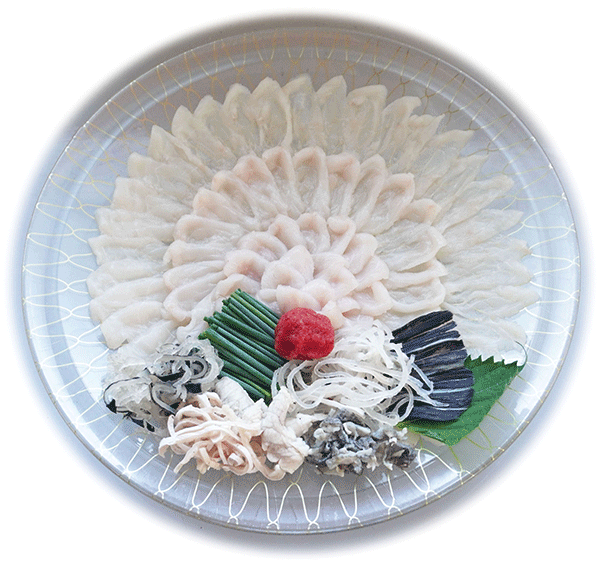
Tiger puffer sashimi
Ban on natural tiger puffer fishing lifted
The first auction of natural tiger puffer fish was held at Haedomari Market in Shimonoseki City, Yamaguchi Prefecture on the morning of Monday, September 26th this year. Following this, at Maisaka fishing port in Hamamatsu City, Shizuoka Prefecture, on October 1st, the ban on natural puffer fish from the Enshu Sea is lifted, so the first auction should be held on October 3rd. Around the time of the update to FISH FOOD TIMES October issue No.226, the season of natural tiger pufferfish will enter.
There was a time when nearly 60% of the natural tiger puffer fish distributed in Japan was caught in the Enshu Sea, which includes Maisaka fishing port. While 90% of tiger puffer fish on the market are farmed, natural tiger puffer fish have a high rarity value, and about 80% of tiger puffer fish caught in Maisaka fishing port in the past were sent to the Haedomari market in Shimonoseki City. These were distributed as 'Shimonoseki brand'. The remaining 20% was sent to Nagoya and Tokyo, and it seems that it was indirectly brought to Osaka, which is the largest consumer of pufferfish in Japan, via the Haedomari market in Shimonoseki.
However, there was a growing trend among locals to offer the natural tiger puffer fish caught in the Enshunada as a local brand, and in 2003, a pufferfish processing plant was established in Hamamatsu City, where it was sold under the brand name of "Enshunada Natural Tiger Puffer" Since then, it has been recognized as one of the leading brands nationwide, such as being certified as a regional collective trademark.
However, as shown in the table below, the amount of tiger puffer fish caught in Enshunada has been declining recently.
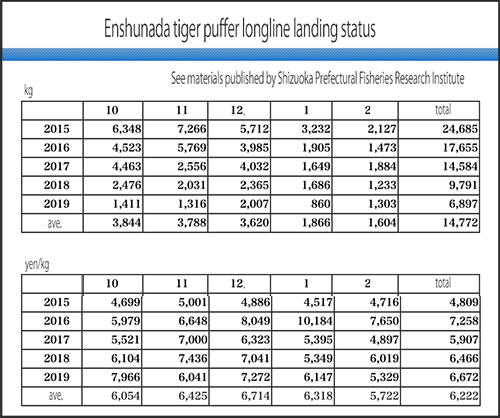
After that, instead of the Enshu Sea, the catch of natural tiger puffer fish has increased rapidly off the coast of Soma City, Fukushima Prefecture in Tohoku, where it was about 2.9 tons in 2019, about 6.3 tons in 2020, and about 27.8 tons in 2021. The fishing started on September 1 again this year, and by mid-September, a total of 8.3 tons were landed, a pace that surpasses last season. In this way, there is momentum contrary to the recent poor catch of natural tiger puffer in the Enshu Sea, and the catch seems to have completely reversed. In January of this year, the Soma Futaba Fisheries Cooperative (Soma City, Fukushima Prefecture) announced that it would sell tiger puffer fish caught in this area under the brand name "Fukutora."
In this way, the momentum of the unloading situation of natural tiger puffer fish is changing from off Enshunada in the Tokai to off Soma City in the Tohoku region. The mass media immediately tries to put this matter to rest with the empty words, "Global warming is the cause." However, I would like to strongly say that the structure in the sea is not something that can be explained simply by such a thing.
For example, in the Enshunada Sea, there is an abnormal occurrence of mackerel puffer, which belongs to the same puffer family and is a detriment to tiger puffer fishing. Mackerel puffers, which have sharp teeth, swarm around trapfish longline fishing rigs in the water and often bite them off. This is the main reason for the decrease in tiger puffer catches, which has continued to be poor in recent years.
Tiger puffer is not the only species of pufferfish. In addition to edible pufferfish such as purple puffer, short-tailed puffer, spotted puffer, and white mackerel puffer, 53 different species of pufferfish have been identified in the waters near Japan alone. As mentioned above, there is no doubt that these are fighting for power in the sea, and especially expensive tiger puffer fish are caught in large numbers by being targeted by humans, which reduces their momentum in the sea.
Natural tiger puffer resources and price trends
On the other hand, according to the document "About tiger puffer resource management" released by the Fisheries Agency in November 2021, the results of the research and analysis are as follows. However, this is a limited number only for the west Japan region of the Sea of Japan, East China Sea, and Seto Inland Sea subgroups of tiger puffer in the figure below.(Please refer to the Fisheries Agency website for the English version of the chart below)
s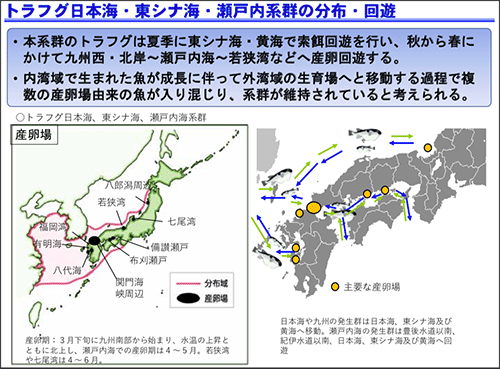
Changes in resource abundance and catch over the past 20 years are shown below.
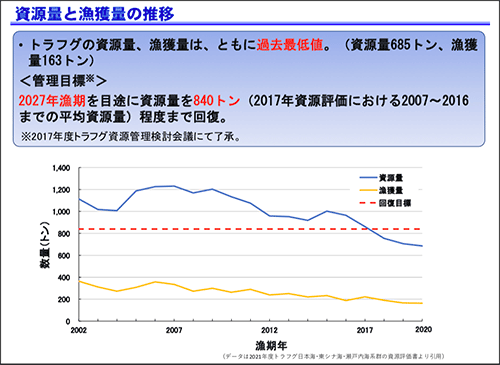
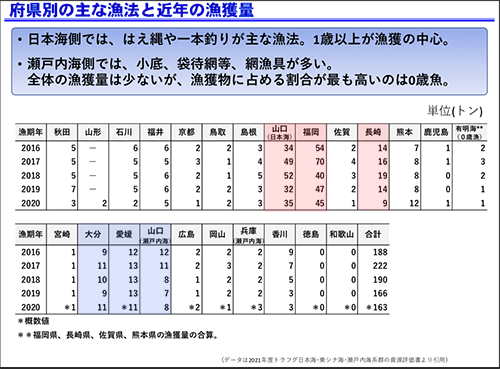
The breakdown of tiger puffer resources is as follows.
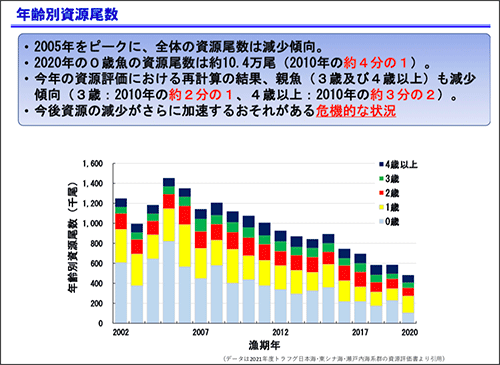
As such, the natural tiger puffer stock is said to be in a "critical situation". The Honjyo Market in Osaka, which is the largest consumer of tiger puffer fish in Japan, determines the price of this rare natural tiger puffer fish. About 60% of tiger puffer fish is consumed in Osaka, and about 30% in Tokyo. After all, Osaka, which is said to be ``a city where many people who eats and drinks extravagantly and becomes poor'', influences the market price of tiger puffer fish. The graph below shows the price transition of natural tiger puffer fish at the Osaka Honjyo market.
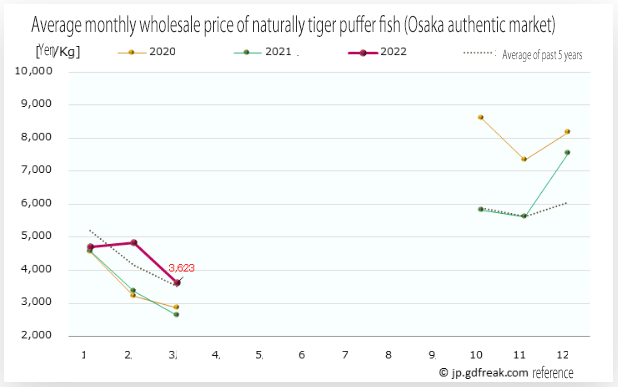
Since the ban on natural tiger puffer fishing will be lifted from October and it will be received, there is a blank in the graph, and the market price of natural tiger puffer will not be established from April to September every year. At the auction held at the Osaka Honjo market in late October 2021, the wholesale price of natural tiger puffer per kg was 7,020 yen at the highest, 5,400 yen at the medium price, and 4,320 yen at the lowest price, compared to the same period in 2020. It was about 40% cheaper. From this, it can be said that the price per natural tiger blowfish in 2021 was about 4,500 to 10,000 yen.
farmed tiger puffer
On the other hand, what about farmed tiger puffer fish?

As shown in this graph, the national production of farmed tiger puffer was 3,824 tons in 2019, which is an order of magnitude larger than that of natural tiger puffer. And what about the price, let's refer to the Osaka Honjyo market price.
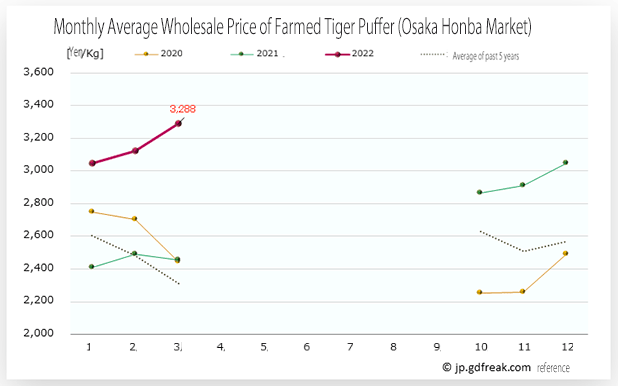
Looking at this graph, I think the average price of farmed tiger puffer is around 2,500 yen/kg, but the market price rose sharply this spring, exceeding 3,000 yen/kg, which is abnormal. This trend continued even at the end of September, and at the end of September, the person in charge of the shop where I requested purchases to make tiger puffer sashimi told me, ``Farmed products are still expensive, so I'd rather use natural products. It's better to do it." was the advice.
It's a time when prices are rising for everything, so I didn't find it very strange to hear that. However, if you think about it, the sharp rise in the market since the beginning of this year was before the war of aggression against Ukraine. I speculated that this may be related to the fact that Japan has switched to a "with corona" policy and the demand for restaurants has recovered.
In the case of cultured fish, not just tiger puffer, there are some things that cannot be ignored, not only the situation in Japan but also the influence of overseas trends on the market. In particular, we cannot ignore the influence of tiger puffer fish from China, so let's take a look at the circumstances around that. Although it is a little old as a material, there is a material announced by Mr. Takeshi Tajima, Chairman of Pacific Trading Co., Ltd. in January 2018, and I would like to introduce it below.
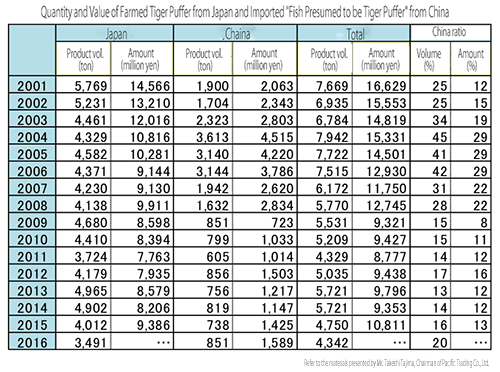
The table above shows the quantity and value of farmed pufferfish from Japan and tiger puffer from China, where the distinction between natural and farmed pufferfish is not clear. And the graph below shows the ratio of whether the contents are live fish, fresh fish, or frozen fish.
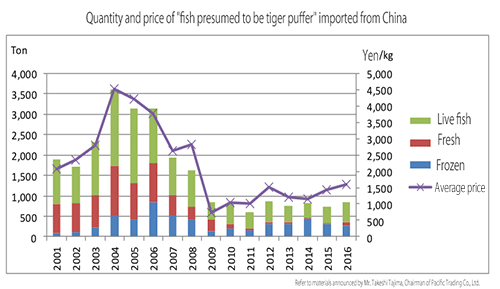
Looking at the above table and graph, it can be inferred that the presence of tiger puffer from China has become weaker than before. In other words, it can be assumed that the current tiger puffer market is not greatly affected by Chinese products. Assuming that the current weak yen continues, it is unthinkable that the import price of tiger puffer from China will fall and affect the domestic farmed tiger puffer market.
Environment for sales of tiger puffer fish
The tiger puffer resource and the environment related to it are as described above, but let's touch on the sales environment next.
The author is not very active in retailing tiger puffer fish sashimi at supermarkets. The reason for this is, first of all, it is not suitable for business dealing with the general public because it is very expensive and has no volume, and its cost performance is poor. Secondly, the process up to commercialization, such as the treatment of poisonous substances, is complicated, including the need for qualifications to dismantle a whole fish and turn it into a product, and the balance between cost and effectiveness is too poor. Thirdly, outpack sashimi, which is made in a factory to omit such a complicated work process and sell it, cannot be confirmed when it was dismantled and how long it was laid. Moreover, it is not delicious to eat from the point of freshness, and even if they purchase and sell these, they have not been profitable due to frequent price reductions and disposal.
Until now, due to the nature of my work, when I was consulted that I wanted to sell tiger puffer sashimi, I would only give advice, "It's probably not profitable, so you should stop doing that." In particular, puffer sashimi has strong regional characteristics, and it can be said that it will definitely not sell at supermarkets in areas other than Osaka, Yamaguchi, and Fukuoka. Even in areas where these products sell somewhat, the level of price reductions and disposal is extraordinary, and puffer sashimi is generally not viable as a retail business.
In other words, puffer's sashimi can be offered to customers as a business only by a special specialty store, and it is a world where unfamiliar people can get burned if they try to do it halfway.
It is well known that a puffer license is required to dismantle and sell puffer fish, but the content of the qualification system differs from prefecture to prefecture. For example, Fukuoka Prefecture, which is one of the homes of pufferfish, requires the following as qualifications for taking the examination. "Persons stipulated in Article 57 of the School Education Act who have been engaged in the processing of puffer fish for 3 years or more, or who have been engaged in the processing of puffer fish for 5 years or more." In addition, in the case of Tokyo, in addition to the conditions of working under a puffer chef in Tokyo for at least two years, you cannot take the puffer chef license exam unless you have a "cook license". Surprisingly, however, Osaka Prefecture, which is the largest consumer of tiger puffer fish in Japan, does not have such a strict qualification requirement.
Yamaguchi Prefecture, which handles the largest amount of tiger puffer fish in Japan, has so far demanded almost the same level of strict eligibility requirements as Fukuoka Prefecture. However, in December 2021, the examination requirement for those who have engaged in pufferfish processing for more than three years will be abolished, and the door to obtaining a pufferfish processing license will be widened. And in this year's exam, a 30-year-old university lecturer with no practical experience in puffer fish processing challenged and passed the practical exam.
To tell you the truth, I don't have a pufferfish processing license either. However, he can dismantle a puffer fish, and although he is not very good at it compared to a skilled craftsman, he can make puffer fish sashimi at the level shown in the opening image. The reason for this is that it does not meet the requirement of "a person who has been engaged in the processing of pufferfish for three years or more." However, although it was a fairly limited period of time, I gained a fair amount of experience dismantling not only tiger puffer, but also purple puffer, white mackerel puffer, etc. For example, during the bitterly cold season of December and January, I put dozens of pufferfish in cold water and squeezed the blood out of their Uguisu bones.
But it's true that I don't have a blowfish processing license. If possible, I have thought several times about trying to take the blowfish processor exam next year in Yamaguchi Prefecture, instead of Fukuoka Prefecture, where the qualification requirements are still strict. However, it is questionable whether it is necessary for the author, who is over 70 years old, to do so, including the future. After all, the author has lived with only "bluff and courage, experience and technique" so far, and does not have any national qualifications. Let me put it in a cool way, so to speak, he's an uncrowned emperor...
Omotenashi
The pufferfish sashimi in the opening image was made because a close friend of mine will be visiting Fukuoka at the end of September from Okinawa, which I visited every month for 13 years until February 2021. This was the conclusion I came to after thinking about what kind of extraordinary hospitality treats that Okinawa does not have. Dismantling tiger puffer fish can be done without a license as long as it is not for sale. However, the poison disposal is troublesome, and I don't want to kill someone important to me, so I had about 1.5 kg of natural tiger puffer fish cut into Migaki state by the manager of the store and bought it.
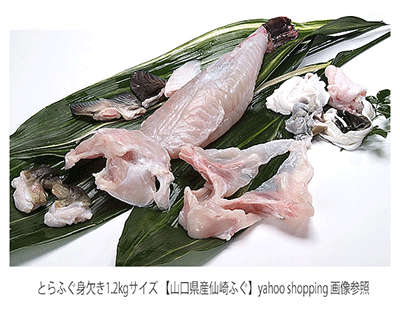
The image of the tiger puffer above in Migaki state is not the one at that time, but an image borrowed from the net, and I bought it in almost the same condition. I bought it at a store that I'm familiar with, and the fisheries manager there not only dismantled it in front of me, but even kawahiki it for me. I was really touched by this because I was feeling heavy when I thought that I had to do kawahiki because the sharp knife would soon become useless. (Thank you for always being so kind to me. I appreciate it.)
I bought Migaki on September 20th (Tuesday), disassembled three pieces, and wrapped it in kitchen paper and film. Then the skin, Toutoumi and Mikawa were boiled and drained immediately. These were left to mature in the refrigerator until the morning of the 23rd. And I made this fugu sashimi on the morning of the 23rd.
This is superfluous, but just in case, I will write it on the condition that it is for people who do not have much knowledge of blowfish. Basically, fugu craftsmen do not dismantle live fugu and make it into sashimi immediately. This is because if the sashimi is made too quickly, shrinkage due to rigor mortis will occur, and the pufferfish sashimi, which is thinly and beautifully plated, will be distorted and will not form the shape you imagined. Also, if you let it sit for a few days, it will mature and become more delicious, and since it is not a live fish, it is easier to make sashimi.
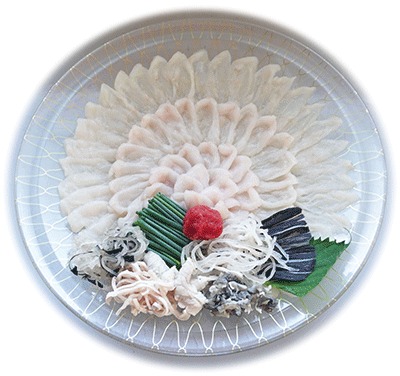
It's been a while since I've made puffer sashimi, so I wasn't sure how it would turn out. Not only that, but I focused on making fugu sashimi because I wanted to make it not only for myself and my family, but for someone who came from far away. And I decided to omit the process photos and take only the finished product. Regarding the dismantling process of tiger puffer and other knowledge, I wrote it in FISH FOOD TIMES February 2011 No. 86, so I would like you to supplement the knowledge that I have not mentioned this time.
For the container, I used the largest round thin plate from Nishiki, 32 cm, but I couldn't put everything on this plate. I tried to put more than half of the skin and Toutoumi on a separate plate, and put the bony parts of the tiger puffer fish in the conger pot on the same table, but in the end it was left untouched.
Well, some of you may have felt that the content of this month's issue is a little different. In the future, I think it's possible that this kind of style will increase in order to make a difference from the previous issue. From now on, I would like to continue to write about fish, "without being bound by anything, freely, as I think."
Dear readers, I hope that you will continue to enjoy and read this website, even though it has such a freewheeling style.
| Please access the following URL if you want to secure using SSL. All pages in the site will be secure pages. |
https://secure02.blue.shared-server.net/www.fish-food.co.jp/message english 10.2022.html |
An opinion and the communication are to iinfo@fish food times
Date of updating 1 Oct. 2022
